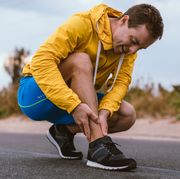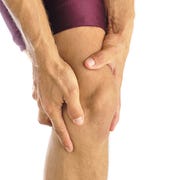The current issue of the British Journal of Sports Medicine has a study by Australian researchers who worked with a group of 384 soldiers during training. At the start of the study, they performed a couple of simple diagnostic tests; then, over the next 16 months, they waited to see who developed shin splints. Sure enough, the tests were pretty good predictors.
(They expressed the results in "likelihood ratios." For the two tests combined, the "positive likelihood ratio" was 7.94, meaning that if you're positive on both tests, you're about eight times more likely to develop shin splints than to not develop shin splints. Conversely, the "negative likelihood ratio" was <0.001, which means that if you're negative on both tests, you're extremely unlikely to develop shin splints.)
Anyway, here are the two tests:
More From Runner's World

(1) Shin Palpation Test
Basically, you squeeze the lower two-thirds of the lower leg, including the shin bone (tibia) and surrounding musculature, "with enough pressure to squeeze out a wet sponge." If there's any pain present, you're positive on that test.
(2) Shin Edema Test
Along the lower two-thirds of the tibia, as shown, press your finger in and hold for five seconds. When you remove your finger, does an indentation remain behind? If so, you have "pitting edema"—basically an accumulation of fluid under the skin—and you're positive for the test.
A positive result on the second test is much less common than on the first test—and it's also a much more accurate sign that trouble (in the form of shin splints) is on the way. And the researchers also found one more key warning sign: the women in the study were three times as likely to develop shin splints than the men. What this means (strangely enough) is that the tests are better at predicting shin splints in men, since they're less likely to develop them in the first place.
So what should you do if you test positive? That's a big (and still controversial) question. The first thing to do is to watch your training load, since shin splints are often associated with sudden increases. Beyond that, I'm a fan of strengthening the muscles around the shin. There are no simple solutions to shin splints, but one thing's for sure: prevention or early treatment are much easier than dealing with a nagging, chronic case.







